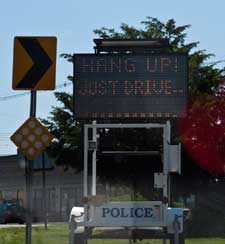 According to an observational survey recently released by The California Office of Traffic Safety (OTS), the number of drivers using cell phones while in transit jumped from 7.3 percent in 2011 to 10.8 percent this year. When it comes to drivers between the ages of 16 and 25, the increase was even more noteworthy, with cell phone usage while driving climbing from 9 percent to 18 percent.
According to an observational survey recently released by The California Office of Traffic Safety (OTS), the number of drivers using cell phones while in transit jumped from 7.3 percent in 2011 to 10.8 percent this year. When it comes to drivers between the ages of 16 and 25, the increase was even more noteworthy, with cell phone usage while driving climbing from 9 percent to 18 percent.
The OTS commissioned study spanned 130 intersections across 17 different counties, and the stats included drivers talking on handheld devices, texting while driving, using Bluetooth headsets, chatting while using a speakerphone, or otherwise manipulating their phone. A similar national study conducted in 2010 placed the usage rate at 9.6 percent.
Two possible explanations for the rise in cell phone usage are the continued proliferation of smart phones as well as young people—who’ve grown up using text messages—becoming new drivers. Another recent study seems to support the latter theory.
After surveying approximately 5,000 college students between the ages of 18 and 29, researchers at UC San Diego found that 78 percent admitted to using a cell phone while driving. The study also found that despite 46 percent of respondents feeling capable or very capable of talking on a cell phone and driving, only 8.5 percent felt confident in the ability of others to do the same. Of even more concern is the fact that 17.5 percent said they had been in a collision due to distracted driving, and the problem continues to increase.
Programs like AT&T’s distracted driving simulator are attempting to teach young drivers they might not be as skilled as they think when it comes to multitasking behind the wheel. Yet, in spite of numerous awareness campaigns, this recent data seems discouraging.
Incidents like the recent death of a Connecticut jogger who was struck by a 16-year-old driver distracted by her cell phone are far too common. Not only could many of these deaths be prevented if the driver was simply paying attention, but it’s also a sad turn of events when an otherwise decent teen ends up facing possible prison time because they made one horrific and life altering mistake.
Hopefully these new studies reiterate the importance of finding an effective way to discourage people from using their cell phone when they’re behind the wheel. It’s not enough to make it a ticketable offense, the real effort needs to be in convincing people they’re not the exception to the rule. Distracted driving is dangerous. Full stop. End of story.
Photo credit: https://www.flickr.com/photos/wrherndon/4714607244/

